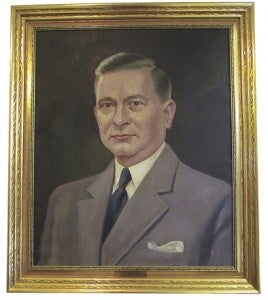A television trailblazer
Published 2:56 pm Wednesday, January 20, 2016
Story by Frank Roberts
In 1929 — before talking motion pictures and between world wars — television was a reality in at least two regions of the United States.
Three afternoons a week, telecasts were already under way in Schenectady, N.Y. on WGY. And in Suffolk, Va., businessman-philanthropist Walter Cecil Rawls was building television receivers in an area where there was nothing to receive.
He established W. C. Rawls & Co. Inc. and started manufacturing combination radio and television receiving sets in console cabinets, according to the National Cyclopedia of American Biography. These consoles were considered the first television receiving sets manufactured and sold on a commercial basis.
“It could be the first,” said Walter Cecil Rawls Jr., an Orange Park, Fla., attorney, referring to the consoles manufactured by his father, who died in 1964. “At least (it was) one of the first commercial television sets manufactured and sold — made in this country for sale.”
WGY went on the air in 1928. In 1930, NBC operated W2XBS, an experimental station in New York City.
But a year before NBC got off the ground, Rawls was building his television sets in Suffolk.
According to an anonymous biography in the files of the Walter Cecil Rawls Library in Courtland, Rawls’ sets were “recognized in the business world as the very first TV receivers ever sold to the American public.”
“My father also had the principle of color TV but didn’t patent it,” Rawls Jr. said. “The disc would go so fast it could create colors in rainbows.”
“RCA picked up the system later,” he said. “They made the same system, but in tubes. My father didn’t realize what he had.”
“Rawls designed a television receiver based on his knowledge of the motion picture projector,” according to Cyclopedia. “He employed engineers to perfect a pilot model.”
“They built the set,” his son said, “but he gave them instructions on how to do it.”
Edwin C. Coulbourn, who had been one of Rawls’ closest friends, said, “The sets were built in a brick building on Morgan Street,” near the Planters Peanut factory in Suffolk. The Zenith Corp. paid him for the rights on a television tube he developed there.”
Company records do not go back that far, according to John Taylor, director of public relations for Zenith in Glenview, Ill. “But there is a good possibility that it happened,” he said. “We didn’t sell picture tubes until the 1940s, but we had been working on them in the late 1920s.”
Rawls never became rich on his contributions to the birth of the television industry. His sets were operationally successful, but they were financial losses.
Rawls Jr. said that the 50 sets his father built were used mostly for research and development.
“TV didn’t go in those years,” he explained. “Transmission was only good for a certain (distance). You needed stations and towers to carry it farther. The country was not set up for commercial television.”
And people were not ready to accept the idea. “Dad used to say that people looked at him as if he was crazy,” his son recalled.
Those people with the technical knowledge, however, did not think that way.
“Dad was in personal contact, had a lot of conversations, with pioneer leaders in the television industry,” Rawls Jr. said. “Magnavox called him often and took his advice.”
But when the Great Depression hit, Walter Cecil Rawls stepped out of the television picture.
The Depression eliminated financial backing of anything connected with that infant industry, and Rawls’ television business went down the tubes.
Through the years, according to his son, “he lost fortunes and made some more.”
But he began with very little. Rawls was born June 13, 1895, on a farm near Ivor, the ninth of the 13 children of Annie Cofer and David Nathaniel Rawls. His father served with the Confederacy during the Civil War.
The Rawls family moved to Suffolk while Walter Cecil was still in school. He dropped out in the eighth grade, however, opting instead for jobs as a newspaper carrier and as a silent movie projectionist at the Academy of Music.
He began to save his money and, with his first $100, became a landowner. Because of his age, his mother had to sign the necessary papers.
Using borrowed money, he built a house and rented it, a procedure he repeated with 12 more homes.
Rawls was such a successful 17-year-old that he was invited to enter into a partnership with an established Suffolk businessman, J. Walter Hosier, running a real estate-insurance business.
In 1917, Rawls was named manager of the Trust Department of Bankers Trust Co. in Norfolk. The next year, when he was 22, he became the firm’s vice-president. In 1920, he moved to New York City, as that company’s credit investigator.
In 1933, he moved to the Midwest, working in various positions with E. H. Rollins & Sons, members of the New York Stock Exchange. They were, at that time, one of the nation’s largest underwriters of securities.
He invested some of his earnings with Magnavox, the company for which he once served as an unofficial adviser.
“He bought them when it was $3 a share,” his son said, “and he grew with the company.”
Fame and fortune gave the Southampton County farm boy the opportunity to constructively hobnob with society.
For the most part, Rawls confined his charitable contributions to his home area and to neighboring Gates County, N.C., where his wife, the former Ella Townsend, was born. The recipients included churches, schools and other organizations.
He and his wife returned to Virginia in 1956, making their home in Blueberry Hill, near Smithfield, and attending Oakland Congregational Christian Church.
One of Rawls’ youthful ambitions was to be a painter. His return to Virginia gave him the opportunity to pursue artistic endeavors and to produce peaceful landscape scenes that were good enough for exhibition.
Rawls retired on a fortune made in banking and investments, yet his fame came from a financial failure — the television sets he manufactured before there was television.








